CU1703
You also want an ePaper? Increase the reach of your titles
YUMPU automatically turns print PDFs into web optimized ePapers that Google loves.
SOFTWAREreview<br />
Tekla Structural Designer 2017 - foundation design<br />
Tekla wall and floor layout<br />
Comprehensive design functionalities<br />
have been provided for all of the common<br />
foundation types required in steel and<br />
concrete structures. It makes foundation<br />
design more efficient by automating some<br />
functions, such as calculating the number<br />
of piles required in a structure, together<br />
with comprehensive calculations and<br />
material take-offs within a single model. In<br />
addition, new wind load processes have<br />
been added which speed the application<br />
of wind loading.<br />
The new tools allow easy application of<br />
horizontal and wind loading, helping<br />
engineers assess the lateral strength<br />
requirements of their structure. Besides<br />
making the process faster, wind loading is<br />
more flexible, making it especially suitable<br />
for structures with challenging geometries.<br />
In practice, wind loading can now be<br />
applied easily on all types of buildings,<br />
either manually or automatically, to comply<br />
with your chosen code of practice.<br />
Engineers can also choose rigid or flexible<br />
diaphragm action to provide complete<br />
control of lateral forces and how they are<br />
distributed throughout the building.<br />
Tekla Structural Designer is a vital tool in<br />
all areas of concrete structural design.<br />
Enhancements to slab design have<br />
revolutionised the design of concrete slabs,<br />
and now include slab splitting tools,<br />
graphical control of panel patches and the<br />
introduction of pass/fail contour diagrams.<br />
Piled mat design efficiency is also<br />
improved thanks to the expansion of TSD's<br />
foundation design capabilities - not a<br />
separate program, but part of the single<br />
modelling environment. Engineers can now<br />
choose between pad, pile cap, mat and<br />
piled mat foundations all within the<br />
same model.<br />
Other features that have been enhanced<br />
include automated pile layout with<br />
comprehensive calculations and material<br />
take off for foundations, and automated<br />
load transfers to foundation - again, part of<br />
the single modelling environment.<br />
Foundation design is now comprehensive<br />
and complete with all the main foundation<br />
types catered for (pad, strip, pile cap mats<br />
and piled mats) for both steel and concrete<br />
structures. With regard to complex<br />
constructions, Tekla Structural Designer<br />
2017 facilitates the analysis of bending on<br />
composite steel and concrete<br />
constructions, enabling engineers to<br />
assess the benefits of composite floor<br />
construction on the overall frame deflection.<br />
The software also provides engineers<br />
with more control and improved design<br />
capabilities, as well as a greater<br />
understanding of a number of more<br />
uncommon structural elements, such as<br />
cambered beams, shear rails, which they<br />
can design to either US or Eurocodes,<br />
bending angles and tee sections - which<br />
can also be designed to comply with US<br />
codes. Punching shear design is a<br />
tedious task, which becomes easier with<br />
this new feature.<br />
TEKLA TEDDS 2017: MORE<br />
CALCULATIONS TO IMPROVE<br />
PRODUCTIVITY<br />
Developed to improve engineering<br />
productivity and quality, Tekla TEDDs<br />
automates repetitive and error prone<br />
structural and civil calculations. In the face<br />
of ever more aggressive deadlines and<br />
demands, Tekla TEDDs enables users to<br />
streamline engineering design by replacing<br />
tedious manual calculations and<br />
spreadsheets with professional and<br />
consistent output. In version 2017, Trimble<br />
has added a large number of new<br />
calculations and enhancements to existing<br />
calculations across various design codes.<br />
Integrated with Microsoft Word, engineers<br />
can now quickly create and customise<br />
calculations and professional<br />
documentation that includes those<br />
calculations, together with sketches and<br />
notes. The new version of TEDDs also<br />
includes a large number of new<br />
calculations and enhancements to existing<br />
calculations across Eurocode, British<br />
Standards, US, Australia & Canadian<br />
codes. These include:<br />
Eurocodes: New steel column and<br />
base plate design, new RC corbel<br />
design, enhanced retaining Wall A&D<br />
and more<br />
British Standard Codes: Update<br />
retaining wall calculations, enhanced<br />
masonry wall panel design and other<br />
calculations<br />
US Codes: RC column design has<br />
been enhanced to display more<br />
accurate profiles, enhanced steel 2D<br />
Member A&D and improved user<br />
experience for wood shear wall design,<br />
to name a few<br />
Australian Codes: New Gabion<br />
retaining wall A&D, enhanced 2D<br />
analysis frame wizard and more<br />
New and enhanced calculations: These<br />
have been added each month since<br />
the September release of TEDDS 2017<br />
www.tekla.com/2017<br />
22<br />
March/April 2017

















